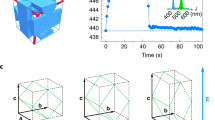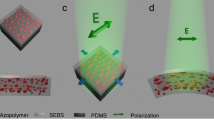Abstract
Responsive photonic crystals have been developed for chemical sensing using the variation of optical properties due to interaction with their environment1,2,3,4. Photonic crystals with tunability in the visible or near-infrared region are of interest for controlling and processing light for active components of display, sensory or telecommunication devices. Here, we report a hydrophobic block–hydrophilic polyelectrolyte block polymer that forms a simple one-dimensional periodic lamellar structure. This results in a responsive photonic crystal that can be tuned via swelling of the hydrophilic layers by contact with a fluid reservoir. The glassy hydrophobic layer forces expansion of the hydrophilic layer along the layer normal, yielding extremely large optical tunability through changes in both layer thickness and index of refraction. Polyelectrolyte polymers are known to be highly responsive to a range of stimuli5,6. We show very large reversible optical changes due to variation of the salt concentration of a water reservoir. These one-dimensional Bragg stacks reflect incident light from the ultraviolet–visible region to the near-infrared region (λpeak=350–1,600 nm) with over a 575% change in the position of the stop band. Our work demonstrates the extremely high responsivity possible for polyelectrolyte-based photonic materials.
This is a preview of subscription content, access via your institution
Access options
Subscribe to this journal
Receive 12 print issues and online access
$259.00 per year
only $21.58 per issue
Buy this article
- Purchase on Springer Link
- Instant access to full article PDF
Prices may be subject to local taxes which are calculated during checkout




Similar content being viewed by others
References
Weissman, J. M., Sunkara, H. B., Tse, A. S. & Asher, S. A. Thermally switchable periodicities and diffraction from mesoscopically ordered materials. Science 274, 959–963 (1996).
Holtz, J. H. & Asher, S. A. Polymerized colloidal crystal hydrogel films as intelligent chemical sensing materials. Nature 389, 829–832 (1997).
Lin, V. S. Y. et al. A porous silicon-based optical interferometric biosensor. Science 278, 840–843 (1997).
Li, Y. Y. et al. Polymer replicas of photonic porous silicon for sensing and drug delivery applications. Science 299, 2045–2047 (2003).
Li, Y. & Tanaka, T. Phase transitions of gels. Annu. Rev. Mater. Sci. 22, 243–277 (1992).
Tanaka, T. Gels. Sci. Am. 244, 124–136 (1981).
Gu, Z.-Z., Fujishima, A. & Sato, O. Photochemically tunable colloidal crystals. J. Am. Chem. Soc. 122, 12387–12388 (2000).
Foulger, S. H. et al. Photonic bandgap composites. Adv. Mater. 13, 1898–1901 (2001).
Debord, J. D. & Lyon, L. A. Thermoresponsive photonic crystals. J. Phys. Chem. B 104, 6327–6331 (2000).
Ozaki, M., Shimoda, Y., Kasano, M. & Yoshino, K. Electric field tuning of the stop band in a liquid-crystal-infiltrated polymer inverse opal. Adv. Mater. 14, 514–518 (2002).
Gu, Z.-Z., Iyoda, T., Fujishima, A. & Sato, O. Photo-reversible regulation of optical stop bands. Adv. Mater. 13, 1295–1298 (2001).
Hu, Z., Lu, X. & Gao, J. Hydrogel opals. Adv. Mater. 13, 1708–1712 (2001).
Fudouzi, H. & Xia, Y. Photonic papers and inks: Color writing with colorless materials. Adv. Mater. 15, 892–896 (2003).
Busch, K. & John, S. Liquid-crystal photonic-band-gap materials: The tunable electromagnetic vacuum. Phys. Rev. Lett. 83, 967–970 (1999).
Xu, X., Majetich, S. A. & Asher, S. A. Mesoscopic monodisperse ferromagnetic colloids enable magnetically controlled photonic crystals. J. Am. Chem. Soc. 124, 13864–13868 (2002).
Hikmet, R. A. M. & Polesso, R. Patterned multicolor switchable cholesteric liquid crystal gels. Adv. Mater. 14, 502–504 (2002).
Kramer, R. M., Crookes-Goodson, W. J. & Naik, R. R. The self-organizing properties of squid reflectin protein. Nature Mater. 6, 533–538 (2007).
Valkama, S. et al. Self-assembled polymeric solid films with temperature-induced large and reversible photonic-bandgap switching. Nature Mater. 3, 872–876 (2004).
Urbas, A. et al. Tunable block copolymer/homopolymer photonic crystals. Adv. Mater. 12, 812–814 (2000).
Deng, T., Chen, C., Honeker, C. & Thomas, E. L. Two-dimensional block copolymer photonic crystals. Polymer 44, 6549–6553 (2003).
Urbas, A. M., Maldovan, M., DeRege, P. & Thomas, E. L. Bicontinuous cubic block copolymer photonic crystals. Adv. Mater. 14, 1850–1853 (2002).
Bockstaller, M. R., Lapetnikov, Y., Margel, S. & Thomas, E. L. Size-selective organization of enthalpic compatibilized nanocrystals in ternary block copolymer/particle mixtures. J. Am. Chem. Soc. 125, 5276–5277 (2003).
Osuji, C. et al. Temperature-dependent photonic bandgap in a self-assembled hydrogen-bonded liquid-crystalline diblock copolymer. Adv. Funct. Mater. 12, 753–758 (2002).
Arsenault, A. C. et al. From colour fingerprinting to the control of photoluminescence in elastic photonic crystals. Nature Mater. 5, 179–184 (2006).
Xia, J., Ying, Y. & Foulger, S. H. Electric-field-induced rejection-wavelength tuning of photonic-bandgap composites. Adv. Mater. 17, 2463–2467 (2005).
Starodoubtsev, S. G., Khokhlov, A. R., Sokolov, E. L. & Chu, B. Evidence for polyelectrolyte/ionomer behavior in the collapse of polycationic gels. Macromolecules 28, 3930–3936 (1995).
Ohmine, I. & Tanaka, T. Salt effects on the phase transition of ionic gels. J. Chem. Phys. 77, 5725–5729 (1982).
Temelkuran, B., Thomas, E. L., Joannopoulos, J. D. & Fink, Y. Low-loss infrared dielectric material system for broadband dual-range omnidirectional reflectivity. Opt. Lett. 26, 1370–1372 (2001).
Pendry, J. B. & MacKinnon, A. Calculation of photon dispersion relations. Phys. Rev. Lett. 69, 2772–2775 (1992).
Hajduk, D. A. et al. Stability of the perforated layer (PL) phase in diblock copolymer melts. Macromolecules 30, 3788–3795 (1997).
Constantin, D. & Oswald, P. Diffusion coefficients in a lamellar lyotropic phase: Evidence for defects connecting the surfactant structure. Phys. Rev. Lett. 85, 4297–4300 (2000).
Rancon, Y. & Charvolin, J. Fluctuations and phase transformations in a lyotropic liquid crystal. J. Phys. Chem. 92, 6339–6344 (1988).
Thomas, E. L., Anderson, D. M., Henkee, C. S. & Hoffman, D. Periodic area-minimizing surfaces in block copolymers. Nature 334, 598–601 (1988).
Acknowledgements
We thank M. Muthukumar for useful discussions. This work was primarily supported by a grant from DARPA and further supported by a Division of Materials Research Polymer Program NSF grant DMR-0308133 and by the US Army Research Office through ISN, under contract DAAD-19-02-D-0002.
Author information
Authors and Affiliations
Corresponding author
Supplementary information
Supplementary Information
Supplementary figures S1-S3 (PDF 5007 kb)
Supplementary Information
Supplementary video S1 (MOV 1958 kb)
Rights and permissions
About this article
Cite this article
Kang, Y., Walish, J., Gorishnyy, T. et al. Broad-wavelength-range chemically tunable block-copolymer photonic gels. Nature Mater 6, 957–960 (2007). https://doi.org/10.1038/nmat2032
Received:
Accepted:
Published:
Issue Date:
DOI: https://doi.org/10.1038/nmat2032
This article is cited by
-
Intelligent block copolymer self-assembly towards IoT hardware components
Nature Reviews Electrical Engineering (2024)
-
The development progress of multi-array colourimetric sensors based on the M13 bacteriophage
Nano Convergence (2023)
-
Functional composites by programming entropy-driven nanosheet growth
Nature (2023)
-
4D Printing in Biomedical Engineering: a State-of-the-Art Review of Technologies, Biomaterials, and Application
Regenerative Engineering and Translational Medicine (2023)
-
Robust and flexible free-standing polyimide/SiOx nanocomposite one-dimensional photonic crystals with high reflectance
Journal of Materials Science (2023)



